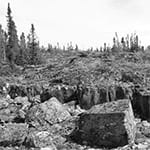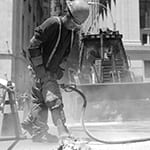Lung cancer – Priority carcinogens
Introduction
CAREX Canada classifies carcinogens based on evaluations made by the International Agency for Research on Cancer (IARC) and assessment of potential exposure in the Canadian setting. This list of occupational and environmental lung carcinogens was drawn from IARC’s List of Classifications with sufficient evidence of carcinogenicity in humans, which was then filtered for priority exposures according to CAREX Canada’s exposure estimate results (see below).
Priority Environmental Lung Carcinogens
Environmental substances were included if they had: 1) a lifetime excess cancer risk estimate of greater than 1 per million people, or 2) a data gap where lifetime excess cancer risk could not be estimated. For more information on how these estimates were calculated, please visit our Methods page.
Canadians may be exposed to higher-than-average levels of asbestos in air if they live near asbestos-containing waste or industrial sites, if they use asbestos-containing consumer products, or if they live or work in buildings with deteriorating asbestos insulation or that have undergone poorly performed asbestos removal.
Canadians are exposed to fine and ultra-fine particles by breathing outdoor air containing emissions from industrial processes, gasoline and diesel engine exhausts, fireplaces, furnaces, and forest fires.
Major sources of diesel engine exhaust include mobile sources (e.g. vehicles and other mobile sources such as ships, locomotives); stationary area sources (e.g. oil and gas production facilities, stationary engines, repair yards, shipyards); and stationary point sources (e.g. chemical manufacturing, electric utilities)
In Canada, radon can be found in public buildings, hospitals and new and older homes. The majority of indoor radon comes from soil gas that enters buildings through cracks and openings in foundations. The highest concentrations of indoor radon are found in areas with uranium and thorium ore deposits and granite formations.
Priority Occupational Lung Carcinogens
Substances were included if they had: 1) high prevalence estimate and medium to high exposure levels estimate, or 2) high prevalence estimate and data gaps preventing assessment of exposure levels. For more information on how these estimates were calculated, please visit our Methods page.
The largest industrial groups exposed to asbestos are construction-related (specialty trades and building construction contribute about 88% of all exposed workers). Other important industries are automotive repair and maintenance, ship and boat building, and site remediation.
The largest industrial groups exposed to diesel engine exhaust are truck transportation, auto repair and maintenance, public administration (local), school and employee bus transportation, and taxi and limo services. A non-road source of exposure is diesel powered equipment used in underground mines and forestry.
The largest industrial group exposed to ionizing radiation is medicine, where exposure occurs with the use of ionizing radiation for diagnostic and therapeutic purposes. Other important industries include nuclear power generation, scientific research, uranium mining, and public administration.
The group of workers with the largest number of exposed individuals is trades, transport, and equipment operators. Other occupation groups with SHS exposure are sales and service, primary industry, and management.
The three largest occupational groups exposed to welding fumes are welders and related machine operators, construction trades helpers and labourers, and automotive service technicians, truck and bus mechanics and mechanical repairers.
Cadmium is used in batteries, pigments, coatings, stabilizers, and alloys. The largest industrial groups exposed are sawmill and wood preservation (through saw-filing or working near saw-filing areas), automotive repair, and commercial and industrial machinery repair.
The largest industrial group exposed to hexavalent chromium is the printing and support activities industry, followed by automotive repair and maintenance, sawmills and wood preservation, commercial and industrial machinery repair and maintenance, and building equipment contracting.
The largest industrial groups exposed to nickel are commercial and industrial machinery and equipment repair and maintenance, motor vehicle parts manufacturing, and architectural and structural metals manufacturing.
The largest industry exposed to crystalline silica is construction, where building construction and trade contractors together account for approximately 54% of exposed workers. Other important industries include heavy and civil engineering construction, metal ore mining, and cement and concrete product manufacturing.
Subscribe to our newsletters
The CAREX Canada team offers two regular newsletters: the biannual e-Bulletin summarizing information on upcoming webinars, new publications, and updates to estimates and tools; and the monthly Carcinogens in the News, a digest of media articles, government reports, and academic literature related to the carcinogens we’ve classified as important for surveillance in Canada. Sign up for one or both of these newsletters below.
CAREX Canada
School of Population and Public Health
University of British Columbia
Vancouver Campus
370A - 2206 East Mall
Vancouver, BC V6T 1Z3
CANADA
As a national organization, our work extends across borders into many Indigenous lands throughout Canada. We gratefully acknowledge that our host institution, the University of British Columbia Point Grey campus, is located on the traditional, ancestral, and unceded territories of the xʷməθkʷəy̓əm (Musqueam) people.







 Ionizing radiation:
Ionizing radiation:


 Hexavalent chromium:
Hexavalent chromium: Nickel:
Nickel: Silica (crystalline):
Silica (crystalline):
